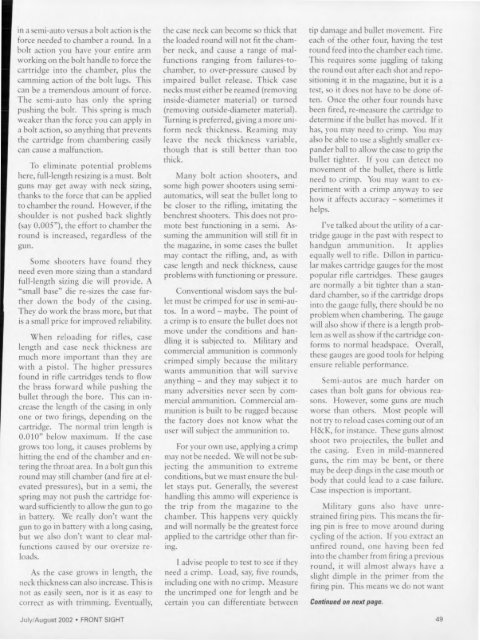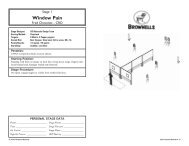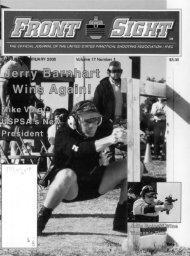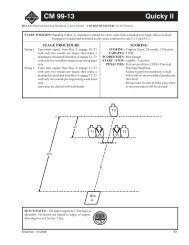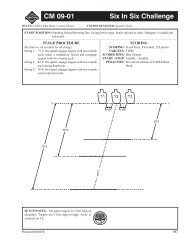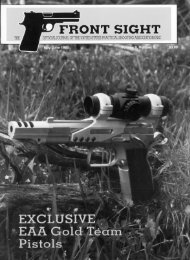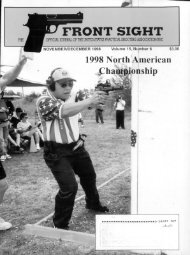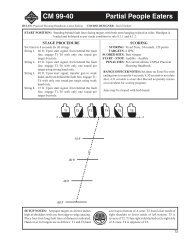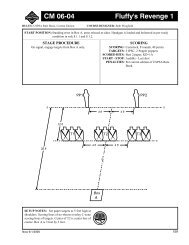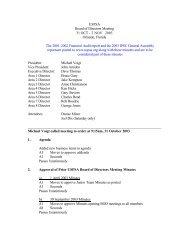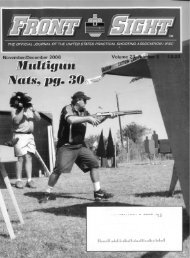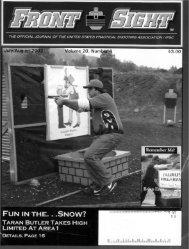You also want an ePaper? Increase the reach of your titles
YUMPU automatically turns print PDFs into web optimized ePapers that Google loves.
in a semi-auto versus a bolt action is the<br />
force needed to chamber a round. In a<br />
bolt action you have your entire arm<br />
working on the bolt handle to force the<br />
cartridge into the chamber, plus the<br />
camming action of the bolt lugs. This<br />
can be a tremendous amount of force.<br />
The semi-auto has only the spring<br />
pushing the bolt. This spring is much<br />
weaker than the force you can apply in<br />
a bolt action, so anything that prevents<br />
the cartridge from chambering easily<br />
can cause a malfunction.<br />
To eliminate potential problems<br />
here, full-length resizing is a must. Bolt<br />
guns may get away with neck sizing,<br />
thanks to the force that can be applied<br />
to chamber the round. However, if the<br />
shoulder is not pushed back slightly<br />
(say 0.005"), the effort to chamber the<br />
round is increased, regardless of the<br />
gun.<br />
Some shooters have found they<br />
need even more sizing than a standard<br />
full-length sizing die will provide. A<br />
"small base" die re-sizes the case further<br />
down the body of the casing.<br />
They do work the brass more, but that<br />
is a small price for improved reliability.<br />
When reloading for rifles, case<br />
length and case neck thickness are<br />
much more important than they are<br />
with a pistol. The higher pressures<br />
found in rifle cartridges tends to flow<br />
the brass forward while pushing the<br />
bullet through the bore. This can increase<br />
the length of the casing in only<br />
one or two firings, depending on the<br />
cartridge. The normal trim length is<br />
0.010" below maximum. If the case<br />
grows too long, it causes problems by<br />
hitting the end of the chamber and entering<br />
the throat area. In a bolt gun this<br />
round may still chamber (and fire at elevated<br />
pressures), but in a semi, the<br />
spring may not push the cartridge forward<br />
sufficiently to allow the gun to go<br />
in battery. We really don't want the<br />
gun to go in battery with a long casing,<br />
but we also don't want to clear malfunctions<br />
caused by our oversize reloads.<br />
As the case grows in length, the<br />
neck thickness can also increase. This is<br />
not as easily seen, nor is it as easy to<br />
correct as with trimming. Eventually,<br />
the case neck can become so thick that<br />
the loaded round will not fit the chamber<br />
neck, and cause a range of malfunctions<br />
ranging from failures-tochamber,<br />
to over-pressure caused by<br />
impaired bullet release. Thick case<br />
necks must either be reamed (removing<br />
inside-diameter material) or turned<br />
(removing outside-diameter material).<br />
Turning is preferred, giving a more uniform<br />
neck thickness. Reaming may<br />
leave the neck thickness variable,<br />
though that is still better than too<br />
thick.<br />
Many bolt action shooters, and<br />
some high power shooters using semiautomatics,<br />
will seat the bullet long to<br />
be closer to the rifling, imitating the<br />
benchrest shooters. This does not promote<br />
best functioning in a semi. Assuming<br />
the ammunition will still fit in<br />
the magazine, in some cases the bullet<br />
may contact the rifling, and, as with<br />
case length and neck thickness, cause<br />
problems with functioning or pressure.<br />
Conventional wisdom says the bullet<br />
must be crimped for use in semi-autos.<br />
In a word — maybe. The point of<br />
a crimp is to ensure the bullet does not<br />
move under the conditions and handling<br />
it is subjected to. Military and<br />
commercial ammunition is commonly<br />
crimped simply because the military<br />
wants ammunition that will survive<br />
anything — and they may subject it to<br />
many adversities never seen by commercial<br />
ammunition. Commercial ammunition<br />
is built to be rugged because<br />
the factory does not know what the<br />
user will subject the ammunition to.<br />
For your own use, applying a crimp<br />
may not be needed. We will not be subjecting<br />
the ammunition to extreme<br />
conditions, but we must ensure the bullet<br />
stays put. Generally, the severest<br />
handling this ammo will experience is<br />
the trip from the magazine to the<br />
chamber. This happens very quickly<br />
and will normally be the greatest force<br />
applied to the cartridge other than firing.<br />
I advise people to test to see if they<br />
need a crimp. Load, say, five rounds,<br />
including one with no crimp. Measure<br />
the uncrimped one for length and be<br />
certain you can differentiate between<br />
tip damage and bullet movement. Fire<br />
each of the other four, having the test<br />
round feed into the chamber each time.<br />
This requires some juggling of taking<br />
the round out after each shot and repositioning<br />
it in the magazine, but it is a<br />
test, so it does not have to be done often.<br />
Once the other four rounds have<br />
been fired, re-measure the cartridge to<br />
determine if the bullet has moved. If it<br />
has, you may need to crimp. You may<br />
also be able to use a slightly smaller expander<br />
ball to allow the case to grip the<br />
bullet tighter. If you can detect no<br />
movement of the bullet, there is little<br />
need to crimp. You may want to experiment<br />
with a crimp anyway to see<br />
how it affects accuracy — sometimes it<br />
helps.<br />
I've talked about the utility of a cartridge<br />
gauge in the past with respect to<br />
handgun ammunition. It applies<br />
equally well to rifle. Dillon in particular<br />
makes cartridge gauges for the most<br />
popular rifle cartridges. These gauges<br />
are normally a bit tighter than a standard<br />
chamber, so if the cartridge drops<br />
into the gauge fully, there should be no<br />
problem when chambering. The gaup<br />
will also show if there is a length problem<br />
as well as show if the cartridge conforms<br />
to normal headspace. Overall,<br />
these gauges are good tools for helping<br />
ensure reliable performance.<br />
Semi-autos are much harder on<br />
cases than bolt guns for obvious reasons.<br />
However, some guns are much<br />
worse than others. Most people will<br />
not try to reload cases coming out of an<br />
H&K, for instance. These guns almost<br />
shoot two projectiles, the bullet and<br />
the casing. Even in mild-mannered<br />
guns, the rim may be bent, or there<br />
may be deep dings in the case mouth or<br />
body that could lead to a case failure.<br />
Case inspection is important.<br />
Military guns also have unrestrained<br />
firing pins. This means the firing<br />
pin is free to move around during<br />
cycling of the action. If you extract an<br />
unfired round, one having been fed<br />
into the chamber from firing a previous<br />
round, it will almost always have a<br />
slight dimple in the primer from the<br />
firing pin. This means we do not want<br />
Continued on next page.<br />
<strong>Jul</strong>y/<strong>Aug</strong>ust 2002 • FRONT SIGHT 49


